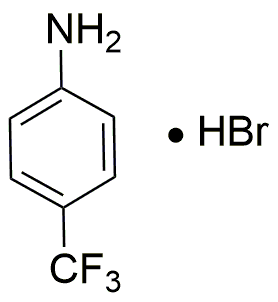4-(Trifluoromethyl)aniline hydrobromide is widely utilized in research focused on:
- Pharmaceutical Development: This compound serves as an important intermediate in the synthesis of various pharmaceuticals, particularly in the development of drugs targeting neurological and cardiovascular conditions.
- Agricultural Chemicals: It is used in the formulation of agrochemicals, including herbicides and pesticides, enhancing their efficacy through improved chemical stability and bioactivity.
- Material Science: The compound is incorporated into polymers and coatings, providing enhanced thermal and chemical resistance, which is crucial for applications in harsh environments.
- Analytical Chemistry: It acts as a reagent in analytical methods, such as chromatography and spectroscopy, aiding in the detection and quantification of various substances due to its unique spectral properties.
- Fluorinated Compounds Research: The compound is significant in the study of fluorinated organic compounds, helping researchers explore new materials with desirable properties like low surface energy and high stability.
General Information
Properties
Safety and Regulations
Applications
4-(Trifluoromethyl)aniline hydrobromide is widely utilized in research focused on:
- Pharmaceutical Development: This compound serves as an important intermediate in the synthesis of various pharmaceuticals, particularly in the development of drugs targeting neurological and cardiovascular conditions.
- Agricultural Chemicals: It is used in the formulation of agrochemicals, including herbicides and pesticides, enhancing their efficacy through improved chemical stability and bioactivity.
- Material Science: The compound is incorporated into polymers and coatings, providing enhanced thermal and chemical resistance, which is crucial for applications in harsh environments.
- Analytical Chemistry: It acts as a reagent in analytical methods, such as chromatography and spectroscopy, aiding in the detection and quantification of various substances due to its unique spectral properties.
- Fluorinated Compounds Research: The compound is significant in the study of fluorinated organic compounds, helping researchers explore new materials with desirable properties like low surface energy and high stability.
Documents
Safety Data Sheets (SDS)
The SDS provides comprehensive safety information on handling, storage, and disposal of the product.
Product Specification (PS)
The PS provides a comprehensive breakdown of the product’s properties, including chemical composition, physical state, purity, and storage requirements. It also details acceptable quality ranges and the product's intended applications.
Certificates of Analysis (COA)
Search for Certificates of Analysis (COA) by entering the products Lot Number. Lot and Batch Numbers can be found on a product’s label following the words ‘Lot’ or ‘Batch’.
Numéro de catalogue
Numéro de lot/série
Certificates Of Origin (COO)
This COO confirms the country where the product was manufactured, and also details the materials and components used in it and whether it is derived from natural, synthetic, or other specific sources. This certificate may be required for customs, trade, and regulatory compliance.
Numéro de catalogue
Numéro de lot/série
Safety Data Sheets (SDS)
The SDS provides comprehensive safety information on handling, storage, and disposal of the product.
DownloadProduct Specification (PS)
The PS provides a comprehensive breakdown of the product’s properties, including chemical composition, physical state, purity, and storage requirements. It also details acceptable quality ranges and the product's intended applications.
DownloadCertificates of Analysis (COA)
Search for Certificates of Analysis (COA) by entering the products Lot Number. Lot and Batch Numbers can be found on a product’s label following the words ‘Lot’ or ‘Batch’.
Numéro de catalogue
Numéro de lot/série
Certificates Of Origin (COO)
This COO confirms the country where the product was manufactured, and also details the materials and components used in it and whether it is derived from natural, synthetic, or other specific sources. This certificate may be required for customs, trade, and regulatory compliance.


